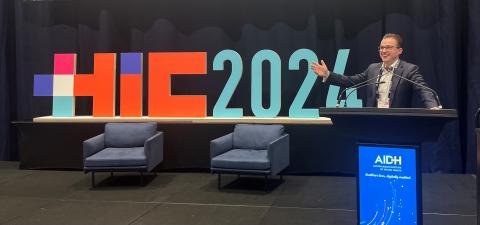Dr Tim Fazio uses genomic data every day in patient care – but he knows there’s so much more to be done with it. Our resident genomic health information Keeley Reade recently sat down with Tim for a deep dive into genomic data.

Keeley Reade: Thanks for doing this, Tim. To kick things off, how does your role intersect with genomics?
Tim Fazio: I wear two hats at the Royal Melbourne Hospital. One as a clinician – I run a statewide service for adults who have rare diseases with a genetic basis. For some, the diagnosis is quite straightforward, but for many, we haven’t worked out it yet.
My other hat is Chief Medical Information Officer, so I’m interested in how we use data to improve patient safety and clinical efficiency.
Your role involves all kind of health data. Why do you think genomic data is starting to get attention?
I think what’s interesting is the different uses for genomic data.
As a clinician, I use it for diagnosis. What is the exact genetic variant behind my patient’s condition, and will that change my treatment approach?
But genomic data can also inform a risk prediction score for heart disease or dementia or early mortality. It could predict a bad response to a drug or tell us which drug might work with a specific patient, and how much of that drug to use. And in cancer care, genomic data helps us target treatments to a specific gene variant within a cancer.
The breadth and scope of genomics is already large and getting larger. I don’t think many of us have yet worked out how to incorporate it into our daily practice to improve patient safety and outcomes.
What can genomics do for Victorian patients? Here are six examples.
Genomic data is certainly useful, but it’s also complex to store and manage. So how do we actually get to use it?

We’re kind of at a tipping point with genomics. I think we understand enough about why it’s useful, and genomic testing is now efficient and cheap enough to become routine practice – but we haven’t yet really leveraged the power of it.
There are ethical challenges with making genomic data accessible, even to patients. For example, if your genomic data predicts that in a certain number of years you’re going to develop a fatal neurological disease, is that something you really want to know? That’s a complex and nuanced conversation for a doctor to have with a patient.
There are also technical challenges. How is genomic data stored? In what format? Is it easily portable? Is it secure? Will it be hosted in one place for doctors and researchers to access?
But locking it away certainly doesn’t help. There’s information in your genome that can impact your clinical care, but not if no one knows about it. It’s a balancing act between knowing what’s there, and how to store it, and who to show it to, and how to use it in a safe way.
How do you manage clinical genomic data?
Discover Genomical® – a Victorian-made solution.
You can see why genomics is slow to adopt because of those nuances and complexities. But what’s interesting is that a genome is essentially a pool of data that has multiple uses over a patient’s lifetime.
That’s right. For example, if you come in with a fever and a cough, we’ll do a test to work out if you have COVID or the flu or something else. But if you come in next year with the same symptoms, we’ll test you again because last year’s test result is no longer useful.
Even a kidney function test or blood glucose test gives you a point-in-time result, although you can track the results over time to see a pattern.
But the information in a genomic sequence does not change over time. If it says you cannot process a particular drug, it’s relevant for you now. It’s relevant for your future doctors and medications you might buy over the counter. It’s relevant for life.
While the data stays the same, our ability to interpret it is changing. Tomorrow there might be new knowledge we don’t have today. For example, I have patients with gene variants of uncertain significance. I check every few years to see whether anyone has done further work to tell us if that variant is benign or is actually the cause of their symptoms.
Now I’m thinking about electronic medical records (EMRs) and how they’re set up. They don’t make it easy for clinicians to see if their patient may have had a genomic test or explore what it shows.
That’s right. And how to store that result in an EMR is an interesting challenge. Is it a PDF that shows the methodology and the findings? Is there a separate report for each gene change identified? How should that data be structured? How can variants of uncertain significance be flagged for review? Do I as a clinician have to request that review? Do I have to hop on different websites and find out for myself, or can it be automated?
That’s a good segue to talk about research. From your perspective, what’s the value of making clinical genomic data available to researchers?
It’s the power of having more data to drive knowledge. Does the existing research reflect the diversities of ancestries we see in Australia? Do we have knowledge of genetics that might be unique to, say, First Nations People, or Pacific Islanders or people from China?
It could be assessing response to therapy. For example, I have patients with a condition called phenylketonuria or PKU. There’s a treatment for PKU that only works for certain genotypes. Right now, I give that medication to all my patients and test their blood to see how they respond. But if we had more genomic data available on PKU patients and their genotypes, I could tell how any new patient was going to respond based on their genome.
Or let’s consider heart disease. We still use an antiquated score to calculate an individual’s risk: How old are you? Are you male? Do you smoke? Do you have diabetes? What’s your weight? What about risk factors that aren’t in that model, like mental health issues or genetics? Can we be more accurate if we include genetics?
Genome-wide association studies can help us predict risks in a very different way. They can tell us things we don’t know, such as whether a particular individual should go on a statin to prevent hypercholesterolemia, or maybe whether they should eat more vegetables or fish, or whether one type of exercise will make more of a difference than another.
Let’s finish with AI. How do you think we could use AI to progress the implementation of genomics?
In some ways, it depends on your definition of AI. There are already advanced mathematical and algorithmic approaches used to make sense of genomic data.
But let’s go back to my patient with a variant of uncertain significance. Maybe a large language model could help curate the medical literature and help me work out whether the classification on that variant has changed recently.
Or maybe it could monitor the discrete pieces of data in the patient’s electronic medical record and compare that to the genomics and the literature. So, when I go to prescribe this patient a medication, it says: ‘Hey Tim, it looks like your patient has the XYZ genotype, and based on this paper in the Journal of Whatever, it looks like Drug A isn’t going to work. Would you like to try Drug B instead?’
I can see the potential for AI in a decision support realm. And people have genuine concerns about safety and reproducibility, but within a framework of good governance, it can be a useful tool for genomics.
Huge thanks for your time today, Tim. We very much appreciate you articulating your thoughts.
Glad it was useful. Always a pleasure.
